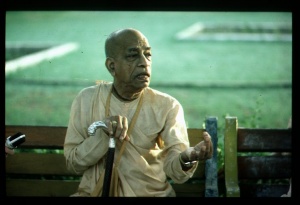CC Madhya 14.8: Difference between revisions
m (1 revision(s)) |
No edit summary |
||
| Line 1: | Line 1: | ||
{{ | [[Category:Sri Caitanya-caritamrta - Madhya-lila Chapter 14|C008]] | ||
<div style="float:left">'''[[Sri Caitanya-caritamrta|Śrī Caitanya-caritāmṛta]] - [[CC Madhya|Madhya-līlā]] - [[CC Madhya 14|Chapter 14: Performance of the Vṛndāvana Pastimes]]'''</div> | |||
<div style="float:right">[[File:Go-previous.png|link=CC Madhya 14.7|Madhya-līlā 14.7]] '''[[CC Madhya 14.7|Madhya-līlā 14.7]] - [[CC Madhya 14.9|Madhya-līlā 14.9]]''' [[File:Go-next.png|link=CC Madhya 14.9|Madhya-līlā 14.9]]</div> | |||
{{CompareVersions|CC|Madhya 14.8|CC 1975|CC 1996}} | |||
{{RandomImage}} | |||
==== TEXT 8 ==== | ==== TEXT 8 ==== | ||
<div | <div class="verse"> | ||
rāsa-līlāra śloka paḍi’ karena stavana | :rāsa-līlāra śloka paḍi’ karena stavana | ||
“jayati te ’dhikaṁ” adhyāya karena paṭhana | :“jayati te ’dhikaṁ” adhyāya karena paṭhana | ||
</div> | </div> | ||
| Line 12: | Line 16: | ||
==== SYNONYMS ==== | ==== SYNONYMS ==== | ||
<div | <div class="synonyms"> | ||
rāsa- | ''rāsa-līlāra''—of the ''rāsa-līlā'' dance; ''śloka''—verses; ''paḍi''’—reciting; ''karena''—offers; ''stavana''—prayers; ''jayati te ’dhikam—''beginning with the words ''jayati te ’dhikam''; ''adhyāya''—chapter; ''karena''—does; ''paṭhana—''recitation. | ||
</div> | </div> | ||
| Line 19: | Line 23: | ||
==== TRANSLATION ==== | ==== TRANSLATION ==== | ||
<div | <div class="translation"> | ||
The King began to recite verses about the rāsa-līlā from Śrīmad-Bhāgavatam. He recited the chapter beginning with the words “jayati te ’dhikam.” | The King began to recite verses about the rāsa-līlā from Śrīmad-Bhāgavatam. He recited the chapter beginning with the words “jayati te ’dhikam.” | ||
</div> | </div> | ||
| Line 26: | Line 30: | ||
==== PURPORT ==== | ==== PURPORT ==== | ||
<div | <div class="purport"> | ||
These verses from Śrīmad-Bhāgavatam, Canto Ten, Chapter Thirty-one, constitute what is known as the Gopī-gīta. | These verses from [[Srimad-Bhagavatam|''Śrīmad-Bhāgavatam'']], Canto Ten, Chapter Thirty-one, constitute what is known as the ''Gopī-gīta.'' | ||
</div> | </div> | ||
__NOTOC__ | |||
<div style="float:right; clear:both;">[[File:Go-previous.png|link=CC Madhya 14.7|Madhya-līlā 14.7]] '''[[CC Madhya 14.7|Madhya-līlā 14.7]] - [[CC Madhya 14.9|Madhya-līlā 14.9]]''' [[File:Go-next.png|link=CC Madhya 14.9|Madhya-līlā 14.9]]</div> | |||
__NOTOC__ | |||
__NOEDITSECTION__ | |||
Revision as of 16:16, 27 August 2021

His Divine Grace
A.C. Bhaktivedanta Swami Prabhupada
A.C. Bhaktivedanta Swami Prabhupada
TEXT 8
- rāsa-līlāra śloka paḍi’ karena stavana
- “jayati te ’dhikaṁ” adhyāya karena paṭhana
SYNONYMS
rāsa-līlāra—of the rāsa-līlā dance; śloka—verses; paḍi’—reciting; karena—offers; stavana—prayers; jayati te ’dhikam—beginning with the words jayati te ’dhikam; adhyāya—chapter; karena—does; paṭhana—recitation.
TRANSLATION
The King began to recite verses about the rāsa-līlā from Śrīmad-Bhāgavatam. He recited the chapter beginning with the words “jayati te ’dhikam.”
PURPORT
These verses from Śrīmad-Bhāgavatam, Canto Ten, Chapter Thirty-one, constitute what is known as the Gopī-gīta.